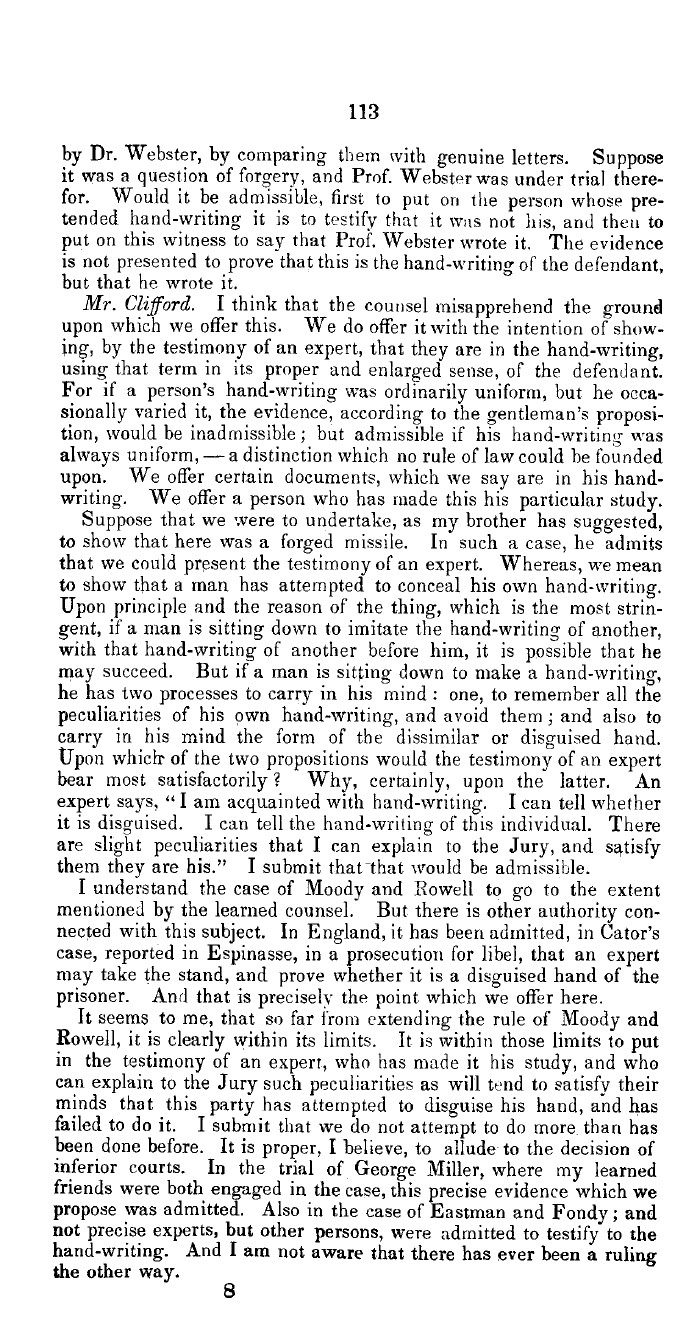|
113
by Dr. Webster, by comparing them with genuine letters. Suppose
it was a question of forgery, and Prof. Websterwas under trial there-
for. Would it be admissible, first to put on the person whose pre-
tended hand-writing it is to testify that it was not his, and then to
put on this witness to say that Prof. Webster wrote it. The evidence
is not presented to prove that this is the hand-writing of the defendant,
but that he wrote it.
Mr. Cliford. I think that the counsel misapprehend the ground
upon which we offer this. We do offer it with the intention of show-
ing, by the testimony of an expert, that they are in the hand-writing,
using that term in its proper and enlarged sense, of the defendant.
For if a person's hand-writing was ordinarily uniform, but he occa-
sionally varied it, the evidence, according to the gentleman's proposi-
tion, would be inadmissible ; but admissible if his hand-writinwas
always uniform,-a distinction which no rule of law could be founded
upon. We offer certain documents, which we say are in his hand-
writing. We offer a person who has made this his particular study.
Suppose that we were to undertake, as my brother has suggested,
to show that here was a forged missile. In such a case, he admits
that we could present the testimony of an expert. Whereas, we mean
to show that a man has attempted to conceal his own hand-writing.
Upon principle and the reason of the thing, which is the most strin-
gent, if a man is sitting down to imitate the hand-writing of another,
with that hand-writing of another before him, it is possible that he
may succeed. But if a man is sitting down to make a hand-writing,
he has two processes to carry in his mind : one, to remember all the
peculiarities of his own hand-writing, and avoid them ; and also to
carry in his mind the form of the dissimilar or disguised hand.
Upon whiclr of the two propositions would the testimony of an expert
bear most satisfactorily ? Why, certainly, upon the latter. An
expert says, 1° I am acquainted with hand-writing. I can tell whether
it is disguised. I can tell the hand-writing of this individual. There
are slight peculiarities that I can explain to the Jury, and satisfy
them they are his." I submit that that would be admissible.
I understand the case of Moody and Rowell to go to the extent
mentioned by the learned counsel. But there is other authority con-
nected with this subject. In England, it has been admitted, in Cator's
case, reported in Espinasse, in a prosecution for libel, that an expert
may take the stand, and prove whether it is a disguised hand of the
prisoner. And that is precisely- the point. which we offer here.
1t seems to me, that so far from extending the rule of Moody and
Rowell, it is clearly within its limits. It is within those limits to put
in the testimony of an expert, who has made it his study, and who
can explain to the Jury such peculiarities as will tend to satisfy their
minds that this party has attempted to disguise his hand, and has
failed to do it. I submit that we do not attempt to do more than has
been done before. It is proper, I believe, to allude to the decision of
inferior courts. In the trial of George Miller, where my learned
friends were both engaged in the case, this precise evidence which we
propose was admitted. Also in the case of Eastman and Fondy; and
not precise experts, but other persons, were admitted to testify to the
hand-writing. And I am not aware that there has ever been a ruling
the other way.
8
|

